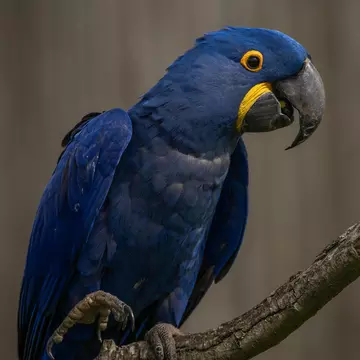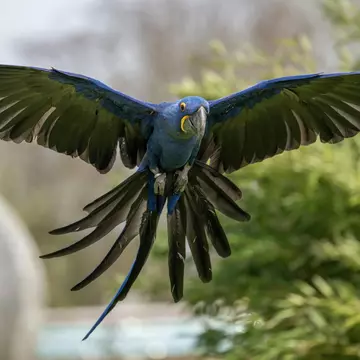
31 May – 1 June
Fly into a weekend of colour, curiosity, and clever beaks as we celebrate World Parrot Day at London Zoo! Join us for a weekend packed with colour, curiosity, and clever beaks as we shine a spotlight on these spectacular animals.
Into the Blue – Meet the Hyacinth Macaws
The world’s largest parrot, with a personality just as bold as its feathers.
With brilliant cobalt-blue plumage and a powerful beak, these incredible birds are as intelligent as they are beautiful. Over the World Parrot Day weekend, come and meet our flock and uncover some jaw-dropping facts that make them true stars of the Zoo.

Powerful Beaks
Not only are these the world’s tallest parrots but their beaks are incredibly strong, exerting just under a tonne of pressure per square inch – that’s enough to bite through a wooden broom handle. They can even break open macadamia nuts, which none of our other parrots can manage.
Brainy Birds
Hyacinth macaws are one of the most intelligent birds at the Zoo, and in the world! We challenge them with puzzle feeders and hidden snacks, and it’s amazing to watch their minds at work. Whether it’s chewing, prying, or strategizing, they always find a way to win their prize.
Mates for Life
Macaws are true romantics, they usually mate for life. They like to nest in tree cavities, laying one or two eggs, and they’re great parents, taking it in turns to feed the chicks. Their chicks enjoy a long childhood too – they’re not considered adults until they’re around seven years old.
Flying Aces
Catch them soaring in our daily flying demonstrations! These skilled fliers love to show off their 'jinxing' – a daring mid-air twist and turn that keeps even our bird keepers on their toes. You won’t believe how agile these birds are.

Why So Blue?
The bluer these birds are, the healthier they are – and the more attractive they are to potential partners. These birds look brightly coloured to us, but they probably look ever more brilliant to each other. Parrots can see ultraviolet light, so they have markings that are invisible to us, but make it easy for them to recognise each other.
Join the Celebration
London Zoo | 31 May – 1 June
Celebrate World Parrot Day with two days of fascinating talks, fun activities, and exclusive insights into the world of parrots. Whether you're a bird lover or just looking for a fun day out, there's something for everyone.
Members, Fellows and Patrons – don’t forget to collect your exclusive parrot pin badge during the celebration weekend!
Book Tickets tODAY
